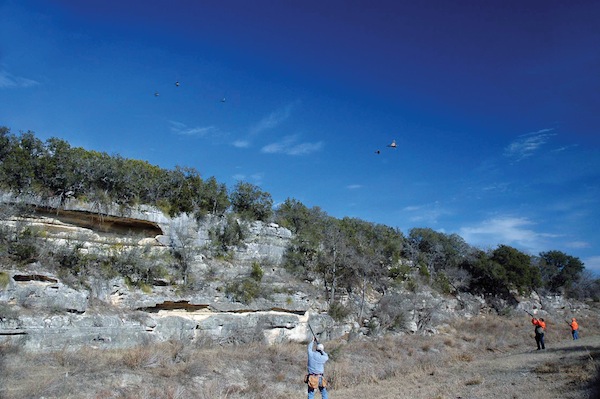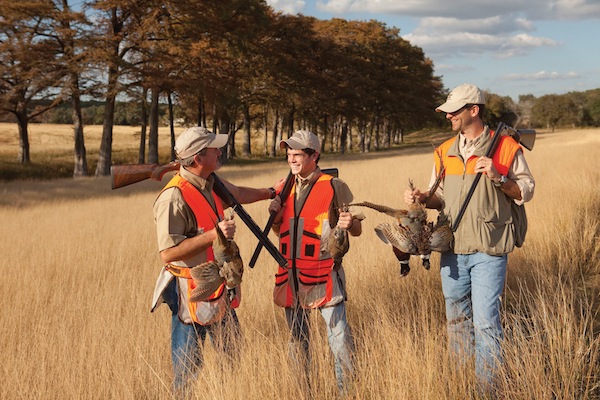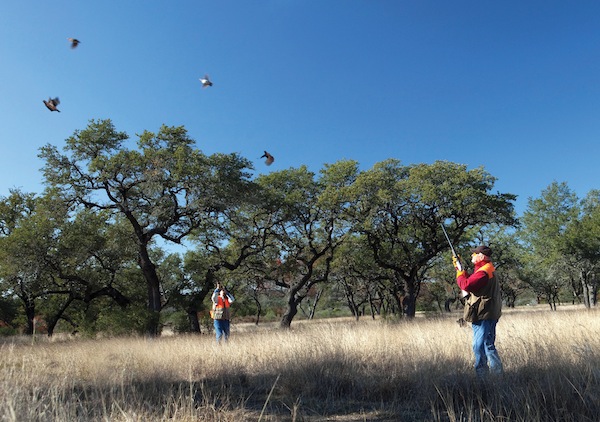Into the Hills, Into Tradition: Joshua Creek Ranch
February 12, 2015



 SCA Articles
SCA Articles

Perhaps the best measure of a hunting or fishing lodge lies at the end of a question: When it comes time to leave, would you rather stay?
It was my third and last day at Joshua Creek Ranch and a saffron sun was poised on the horizon as we headed back to the lodge after a full day of gunning quail over the dogs and high pheasants in the shadows of towering limestone cliffs. The hunting had been nothing short of spectacular. The next morning would bring a five-hour drive to Dallas and our Sporting Classics booth at the Dallas Safari Club Exhibition. It wasn’t so much that I dreaded making the drive all alone, I’d simply fallen in love with this crown jewel in the Texas Hill Country and I would have treasured a few more days a few more days of hunting not only its high-tailing gamebirds, but the beautiful axis deer that roam freely over the ranch.
I’d almost canceled my January visit to Joshua Creek Ranch when my hunting companion came down with the flu the day before our departure. That left me with some serious reservations, because my fondest hunting adventures have invariably been shared with good friends.
I thought about rescheduling, but decided against it because I was eager to see the many improvements Joe and Ann Kercheville had made since my first hunt there in 1999. In fact, Beretta had just recently selected Joshua Creek Ranch as one of the first lodges in its new Trident program, a prestigious acclamation given only to the finest hunting operations in the world.
My final day of hunting had certainly begun on a high note. Ann and ranch manager David Edwards had arranged for me to sample four different sites where they host driven shoots for high-flying pheasants.
Our fist stop that morning was Bull Hill, a brush and boulder-strewn bluff that rose more than 80 feet above a patchwork of narrow fields planted in oats and sorghum. There, guide Eric Harrison, photographer Ric Dentinger and I settled into a grassy swale to await the first flight. Eric had enthusiastically agreed to serve as my bird-shooting partner and he proved to be a wonderful companion and a first-rate shot.
Driven from the high bluff-top, the first pheasant scolded us with a raucous cuck-cuck-cuck, then instantly flared away, well out of gun range. The second bird tried a similar tactic, but my young guide managed to scratch it down with a nifty 60-yard shot. All of the remaining six pheasants passed within range of our 12-bore Berettas – though just barely – and we managed to drop five, each quickly retrieved by Boogie, Eric’s effervescent little English Cocker.
“We call these birds our ‘stars’ because they’re so high in the sky,” joked Eric as we drove to the next site. “They’re even high at a couple of the other hills.”
Within minutes we arrived at Domeier II, where a sheer, 100-foot wall of sun-washed limestone loomed high above the Guadalupe River. This time the first pheasant appeared as little more than a distant silhouette plummeting on cupped wings like a falcon toward the filed behind us. Twice I led the rooster a good ten feet, but both shot charges passed cleanly behind his long tail.
What followed at Domeier II and the other sites we gunned was more of the same: feathered specks that seemed to fall from the clouds and then rocket past our guns. Every shot was challenging, and by morning’s end we missed more birds than we’d bagged.

The dedicated staff at Joshua Creek has set out to replicate every aspect of traditional driven shoots on the British Isles, which means good food and beverages before and after the drives.
After gunning our last eight-bird site, we moved to a park-like setting beneath a lacy canopy of Texas live oaks where we enjoyed a tail-gate lunch of fresh fruits, finger sandwiches and muffins, sweet tea and coffee. Referred to as an “elevensie” by British sports, the lunch was just what we needed for the next three hours of hunting the ranch’s wild and wooly quail.
Our afternoon hunt whisked me back to my teenage years in South Dakota when I would walk out the back door of our home, cut across the yard and the ball diamond across the street, then step into my hunting grounds, first the tangly edges by the town dump and farther on, miles of weedy roadsides and adjacent cornfields. Back in the late ’50s it was nothing to bag a three-bird limit in an hour or two, even without a dog.
I soon discovered that Joshua Creek’s network of ranch roads offered bird-shooting that far surpassed even my best days afield in South Dakota. We also had the invaluable assistance of Pearl and Jessie. Eric’s well-trained setters, and Java, another of his animated little cockers, to find and retrieve the birds.
After unloading the dogs, we started down one of the gravel roads, the setters sweeping out ahead. Weaving through the tawny grasses, they soon locked up in tense, quivering points, but with their noses pointed in opposite directions. The grassy cover was relatively thin, so I anticipated a couple of singles or at most a small covey.
As Eric and I edged closer, he released the cocker, who dodged and bounced through clumps of grass before sticking his nose into a veritable beehive of birds.
Suddenly the whole world exploded at our feet as a big covey broke from cover, most of the quail going straight-away except for one cockbird that almost grazed the bill of my cap. Then, just as three of the birds tumbled back to the ground, up jumped another covey…. Then another covey… and yet another. I was so stunned by the number of birds that I didn’t even think to reload. There had to be 80 in all, and how every last one of them had remained invisible in the sparse cover still causes me to wonder.
We continue along the road, the dogs coursing ahead, combing the different pockets of cover until they picked up a scent trail and then sliding onto point, their plumed tails arched high over their backs. Before long Eric’s game vest was bulging with quail.
Our next stop was the field below the tall ledge at Domeier II where we’d shot high-flying pheasants that morning. We worked the fields and skirted the edges where the dogs, still as statues, pinned down small coveys of quail and chukar and brightly colored pheasants that hurtled through the cool Texas air.
Our last strip of cover led us by the Domeier house, a weathered limestone structure built by the family who’d settled this part of the ranch in the 1860’s. Set in a nostalgic landscape of bronze and gold grasses, the old, two-story home is a classic reminder of the Hill Country’s storied past.
With its countless natural springs and miles of crystal-clear streams, the Texas Hill Country has always provided an abundance of wild game for hunters, including the first Indian tribes who settled in the region more than 10,000 years ago. one of these tribes was the Tonkawa, who refused to farm the stony soils, preferring instead to hunt deer, turkey, and other birds. Tonkawa, in fact, means “the people of the wolf,” and these early inhabitants believed they were direct descendants of the savage predators.
Native Americans lived in the Hill Country for thousands of years before the Europeans arrived, many of them German immigrants who established ranches and founded such towns as Fredericksburg, New Braunfels, Kerrville, and Boerne. Scattered throughout the region are hundreds of ranch hoses and other picturesque buildings fashioned from limestone that reflect a Germanic influence.
One of these distinctive, cut-limestone homes is now Cypress Lodge, which sits on a small ledge above Joshua Creek’s crystalline, spring-fed waters that wind through a magnificent corridor of ancient cypress trees. You will never find a more picturesque setting for a lodge or a better place to enjoy delicious, lavishly created meals.
When Ann had first invited me to the ranch, I’d expressed my desire to hunt up a big whitetail along with gamebirds.
“Quite honestly,” she’d responded, “few Hill Country Whitetails grow antlers like you see on bucks in other parts of Texas. But we do have hundreds of Axis deer and many really outstanding bucks.”
At first I was disappointed by her response, but now that I’ve hunted axis, I’m indebted to Ann for introducing me to this fascinating cervid from India and Sri Lanka. Indeed, I would ultimately discover that Joshua Creek Ranch has established its own tradition of hunting free-ranging axis deer.
Known as chital or spotted deer in the foothills of the Indian Himalayas, axis were first brought to Texas in 1932. Today, some 40,000 thrive in the Lone Star State, more than twice the number that survives in India.
Many Texans and visiting sportsmen pursue axis not only for their impressive antlers, but for their meat, which is the leanest and best-tasting of all the venisons. Yet oddly enough, Texas Parks & Wildlife wants nothing to do with the animals. They’re officially classified as an exotic species, so there are no regulations for hunting them. You can shoot 20 a day or pursue them at night with spotlights if that’s your wont.
Such a beautiful animal deserves better.
Both sexes have striking, reddish-brown coats marked with uneven rows rows of brilliant white spots and a white throat patch. mature bucks weigh upwards of 200 pounds and typically display three-pronged, lyre-shaped antlers that can measure up to 36 inches in length.
Unlike whitetails, axis deer breed year-round. The males come into rut the same month they were born, which means that at any given time of the year you might see a newly shed buck, another in velvet and another with fully grown antlers, all in one herd. In the Hill Country, however, the prime breeding season – when most bucks are hard-horned – runs from April through September.
With their keen eyes and superb sense of smell, axis are every bit as smart and elusive as whitetails. What makes them somewhat easier to hunt are their loud vocalizations and their herding instinct. Rutting bucks issue bugle-like bellows, enabling you to pinpoint their location.
Axis herds range form five to as many as 100 animals, so when you spot a doe, get ready because there is sure to be a buck nearby. When coming out to feed, the heard will usually be led by an old, experienced doe followed by other females and immature animals, with the biggest bucks in the center or at the rear of the heard.
Our first morning in a comfortable box blind produced what Texas is famous for – White-tailed deer. At least a dozen of the animals emerged from a dark oat motte just after daybreak. But no axis deer.
That evening Eric took me to an elevated stand overlooking an immense field of cutover sorghum laced with strips of Klein grass, a tall-growing import from Africa that seems to thrive in the dry climate. Soon we were treated to a rollicking revue featuring nine whitetail does and yearlings that popped up from their beds in the grass and began a bizarre game of tag, leaping and cavorting and chasing one another across the field for an hour or so.
We were so absorbed in their wild antics that we almost missed an axis doe ghosting out of the woods and into the field. We watched her for several minutes, then just as a dense fog stole across the land, the rest of the herd single-filed from cover. In the dying light we could make out two mature bucks that had already shed, but nothing with hard antlers.
The next morning found us in a valley cut by a meandering ranch road where we kept close watch on two feeders. About an hour after sunrise a herd of axis appeared, mostly does and yearlings along with two big-bodied males. Once again, both were antlerless.
After lunch Eric brought us to a spacious ground blind situated on a wide, grassy plateau with a small meadow out front. It was mid-afternoon when an axis doe stepped from the trees and into the meadow. behind her, one by one, came the entire herd, among them a mature buck with a handsome set of tall, burnished antlers.
“That’s a pretty good buck,” Eric said. “I’d guess twenty-seven or twenty-eight inches. What do you think?”
I’d already made up my mind, for centered in my scope was one of the prettiest game animals I’d ever seen. At my shot the buck raced off into the trees, though we found him piled up less than 50 feet away.
He wasn’t the biggest axis buck in Texas, but he was truly beautiful, with a rich, russet coat sprinkled with white spots and a distinctive black stripe that ran the length of his back. His chestnut-colored head was marked by a dark chevron, which becomes even darker as a buck grows older, giving its face an unusual “scowling” expression.
On the way back to the lodge, Eric asked, “So what do you think of axis deer now that you’ve hunted them?”
“This has been great,” I said. “I’d love to come back when more of the bucks are hard-horned and see if I could get a bigger one.”
“We can make it happen,” Eric replied.
In Eric’s words lies the essence of hunting at Joshua Creek Ranch. Joe and Ann Kercheville and their entire staff go all out to “make it happen” for each and every guest, with always-courteous service, fine dining and accommodations, and some of the best bird and axis hunting you’ll find anywhere.
The Kerchevilles purchased the ranch in 1986 as a relaxing get-away from their home near San Antonio. “We had done a lot of shooting around the world,” said Joe, “and met a lot of Americans like us… people who enjoyed hunting overseas, but knew it could be a big hassle, both in time and money.”
“After experiencing a couple years of driven pheasant shooting in Scotland, we realized that the topography of our ranch and the style of existing structures were ideal for providing European-style hunts, complete with gourmet meals and upscale accommodations. WE were the first to do this in Texas and over the years we’ve proved there is a big demand for what we have to offer.”
After opening the ranch to hunting in 1990, the Kerchevilles set out to establish an extensive system of ranch roads and stock ponds, while converting hundreds of acres of ragged cedar woodlands into pastures and cropfields for deer and gamebirds. They completely refurbished Cypress Lodge and added several buildings, among them two distinctively furnished guest hauses on a bluff high above Joshua Creek.
“We’ve also placed the ranch under a conservation easement, which ensures that it will never be developed – that it will remain in wildlife habitat,” Joe said.
He paused a moment and then added: “We’re doing this because we love hunting and fishing. But the biggest blessing of all is the friends we’ve made, people who share our interest and our passion for wildlife. To me, that’s really the bottom line.”
IF YOU WANT TO GO
Bird-shooting at Joshua Creek Ranch runs form September 1 to March 31; axis deer can be hunted year-round, but for a trophy buck, you’re best bet is from April to September.
New this year are one- and two-night Dove hunting packages in some of Texas’ finest dove-fields. you can bag your limit of whitewings or mourning doves, then enjoy refreshments on your return trip to the ranch where a gourmet game dinner prepared by chef Kay Read awaits. Dove hunts are scheduled September 1 to October 24.
Each summer the ranch hosts Sporting Clays Leagues on its fully automated course, one of the most challenging and scenic in the country. Shooters can compete in 12-gauge and 20/28-gauge classes – or both.
For more information about Joshua Creek Ranch and its hunting and shooting programs, give them a call at (830) 230-5190 or email: info@joshuacreek.com.

